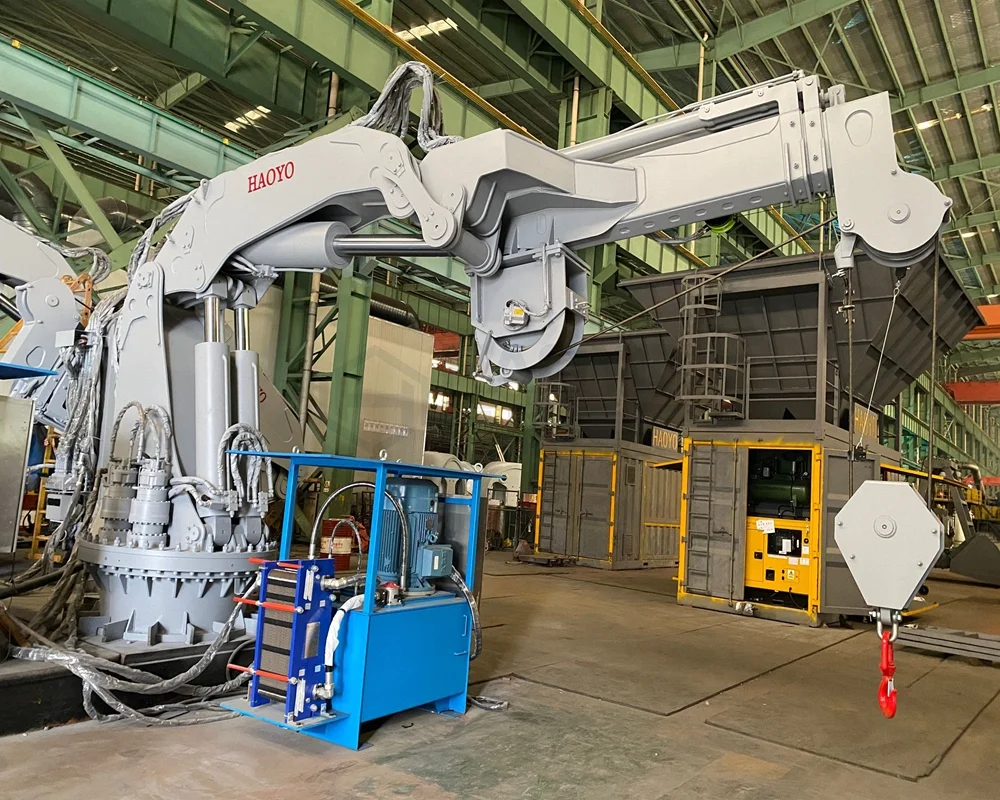- This topic is empty.
-
AuthorPosts
-
2025-05-19 at 2:27 pm #84197
Under the background of changing working conditions, a boom equipment with stable structure and reliable performance is particularly important. Stiff boom crane is a "star equipment" born in this environment. It is widely used in various ships and offshore platforms and has become a key mechanical system in the operation of ships. This article will deeply analyze the technical and practical value of stiff boom crane from the aspects of structural principle, application scenario, advantages and characteristics, selection points, daily maintenance, etc.
1. What is a stiff boom crane?
Stiff boom crane is a marine lifting equipment with a fixed boom structure. Its boom is generally made of high-strength steel and does not bend or stretch during lifting operations. Compared with telescopic or flexible boom cranes, rigid boom structure is more stable and has strong wind resistance, which is particularly suitable for high-load lifting tasks under complex working conditions at sea.
Its main structures include: boom, slewing mechanism, hydraulic system, control platform, wire rope and hook, etc. It has functions such as horizontal rotation, up and down lifting, and fixed angle swing, which can adapt to a variety of loading and unloading and lifting tasks.

2. Application scenarios of stiff boom cranes
Stiff boom cranes are mainly used in the following fields of ships and offshore platforms:
Cargo ships and container ships: used for dock loading and unloading or offshore material transfer;
Offshore engineering ships: such as pipe-laying ships, salvage ships, wind power installation ships, etc., for heavy equipment lifting;
Fishing vessels: lifting fishing nets, fishing gear or heavy objects in fishing operations;
Oil platforms and FPSO (floating production storage and offloading units): used for equipment maintenance, oil pipeline lifting, etc.;
Navy ships and supply ships: for offshore supply and equipment transfer;
Rescue and emergency ships: such as salvage and rescue ships, fireboats, etc., for high-intensity lifting tasks.
In these scenarios, stiff boom cranes are favored for their compact structure, stable operation and rapid response.
3. Advantages of stiff boom cranes
Stable structure and strong wind resistance: The rigid boom adopts a high-strength rigid arm frame, which does not need to be telescoped. The integrated structural design enables it to maintain stable lifting even in harsh sea conditions, avoid excessive shaking during operation, and ensure the safety of personnel and goods.
Fast response and high operating accuracy: The rigid boom has a clear range of motion and high controllability. With advanced hydraulic systems and electronic control technology, it can achieve precise positioning and lifting, and can efficiently complete tasks in a small space.
Simple maintenance and high reliability: Due to its simple structure and relatively few moving parts, its daily maintenance cost is lower and the failure rate is low, which is suitable for long-term and high-frequency ship operations.
Strong adaptability and coverage of multiple working conditions: Whether it is near-shore port loading and unloading, ocean shipping supply, or heavy equipment scheduling on the platform, the stiff boom crane can respond flexibly and support customized models of different tonnage and working radius to meet differentiated needs.
4. Key points for purchasing stiff boom cranes
When buying stiff boom cranes, companies need to consider the following factors comprehensively:
Lifting tonnage: Clarify the maximum load tonnage required for lifting in ship operations. Common models include 3t, 5t, 10t, 20t, etc. Some special ships may require larger tonnage customization.
Boom length and operating radius: Set the appropriate boom length according to the ship deck space and lifting position to avoid the boom length being too short and limiting the operation, or the boom length being too long and causing structural instability.
Rotation angle and control method: The optional 360° full rotation function can improve the flexibility of operation. In terms of control method, manual control, electric remote control or wireless remote control can be selected, and the convenience and safety of operation need to be considered.
Power supply and hydraulic system configuration: Match the corresponding voltage (such as 380V, 440V) and hydraulic pump group according to the hull power system, and pay attention to its power, flow and matching cylinder performance.
Environmental adaptability: If long-term offshore operations are required, lifting equipment with anti-corrosion treatment (such as hot-dip galvanizing, epoxy spraying) must be selected to extend the service life and prevent seawater erosion.
5. Precautions for daily use and maintenance
In order to ensure the safety and stability of rigid jib cranes, the following points should not be ignored in daily use and maintenance:
Pre-operation inspection: Before each lifting operation, check key components such as wire ropes, hooks, brakes, hydraulic oil levels, etc. to ensure that the equipment is normal before it can be used.
Operator training: Crane operation should be performed by professionally trained personnel, strictly abide by the operating procedures, and prevent accidents caused by misoperation.
Regular lubrication and maintenance: Regularly add lubricating oil to all rotating shafts, hydraulic cylinders, and boom connection points to keep the machine running smoothly and prevent parts from wear.
Corrosion protection: Especially in high salt spray environments, the surface anti-corrosion layer should be checked regularly to see if it is intact, and spray repair treatment should be performed if necessary.
Annual inspection and maintenance records: It is recommended to conduct a comprehensive inspection of the jib lifting system every year, including load testing, electronic control system testing, etc., and establish a maintenance file to record the details of each inspection and maintenance.
6. Future development trend of stiff boom cranes
With the development of marine economy, stiff boom cranes are constantly evolving towards intelligence, high performance and low energy consumption:
Intelligent control system: cooperate with PLC and sensor technology to realize load monitoring, early warning system, remote fault diagnosis and other functions;
Modular design: improve the efficiency of installation and disassembly of the whole machine, and facilitate shipyard integration and later upgrades;
Green environmental protection technology: such as the use of energy-saving hydraulic system and variable frequency control motor to reduce energy consumption;
Unmanned operation and automatic lifting system: help the construction of future smart ships and unmanned operation platforms.
As an indispensable lifting equipment in ship and offshore operations, stiff boom cranes have become a "powerful assistant" for many marine engineering projects with their solid structure, strong adaptability and good stability. With the advancement of science and technology and the upgrading of the shipbuilding industry, stiff boom cranes will continue to expand their application boundaries while ensuring operating efficiency and safety, and escort marine logistics and engineering operations.
http://www.haoyotech.com
SHANGHAI HAOYO MACHINERY CO., LTD. -
AuthorPosts
- You must be logged in to reply to this topic.


